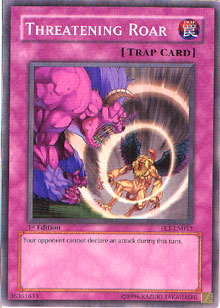Monarchs have been dominating the format since Lazaro Bellido took an incredible build to a Top 8 performance at Shonen Jump Championship Boston. He wasn't the only one to do so, but his deck became the template for the decks run by runner-up Ryan Spicer and SJC Champions Kyle Lopez and Hooman Farahbakhsh. This basic template has quickly become the most netdecked build, and right now you should either be trying to improve or beat the deck.
Unfortunately, beating the deck usually means making more conservative plays and not allowing the opponent to take any advantage of unused cards. While many players are able to accomplish this, it doesn't work so well against the cookie cutter builds that are less Monarch oriented. In addition, playing too conservatively is a good way to lose a game to Cyber-Stein. So the question becomes how do you conserve your cards perfectly without also losing the game? This is where Kevin Wang's SJC Seattle Top 8 deck comes into play:
Monsters—20
1 Sangan
1 Magician of Faith
3 Thestalos the Firestorm Monarch
3 Zaborg the Thunder Monarch
2 Apprentice Magician
2 Old Vindictive Magician
1 Breaker the Magical Warrior
1 Treeborn Frog
1 Spirit Reaper
3 Cyber Dragon
1 Night Assailant
1 Morphing Jar
Spells—15
1 Heavy Storm
1 Mystical Space Typhoon
1 Premature Burial
1 Pot of Avarice
1 Graceful Charity
2 Enemy Controller
2 Brain Control
1 Confiscation
1 Creature Swap
1 Nobleman of Crossout
1 Book of Moon
1 Scapegoat
1 Last Will
Traps—5
1 Ring of Destruction
1 Torrential Tribute
2 Threatening Roar
1 Mirror Force
 This deck contains the standard triple Zaborg the Thunder Monarch and triple Thestalos the Firestorm Monarch set. The Apprentice Magician engine exists as well, allowing the deck to gain an advantage in the same way our standard template does. In fact, the monster line-up is barely different from the one you're used to seeing. It's missing the Mystic Tomato cards, however, which is a pretty key difference.
This deck contains the standard triple Zaborg the Thunder Monarch and triple Thestalos the Firestorm Monarch set. The Apprentice Magician engine exists as well, allowing the deck to gain an advantage in the same way our standard template does. In fact, the monster line-up is barely different from the one you're used to seeing. It's missing the Mystic Tomato cards, however, which is a pretty key difference.
Spicer's build uses Mystic Tomato to keep field presence the same way Apprentice Magician would. The Tomato is the standard stop-and-go monster, which can be used for defense or offense at any time. At the same time, it brings out Sangan, which makes a great Monarch tribute, and fetches Treeborn Frog, the even better Monarch tribute. Kevin Wang doesn't play it though. Instead, he keeps his monster count at a relatively low 20.
Having only 20 monsters in a Monarch deck is actually quite a new development. Most Monarch decks tend to keep their monster counts at around 23-24. While this means you've got fewer options per turn than a lower monster count, it also means you don't run the risk of being unable to play a monster every turn. Devoting over a quarter of your monsters to Monarchs the way Kevin Wang has is generally deemed a big risk. But Kevin has found ways around it while simultaneously giving the Monarch template a way to beat Cyber-Stein.
 Enter Threatening Roar: the perfect way to set up a tribute for next turn. Protecting your monsters from destruction means they'll be around for you to offer as a tribute. While the cost of using Threatening Roar cards may seem unnecessary, the effect of your Monarch next turn will likely balance it out. It becomes especially effective when your opponent attempts to attack with Cyber Dragon, is blocked, and sets another monster. That leaves your opponent open next turn. Imagine that you've got Old Vindictive Magician and Thestalos the Firestorm Monarch ready. Using the effects of both monsters and assuming the attack on Cyber Dragon goes through, you've picked up a trade of your Threatening Roar and Old Vindictive Magician for your opponent's two monsters and a card in hand. Plus you've got a 2400 ATK monster on the field ready to cause trouble for the opponent next turn or force out a monster removal card. This kind of disruption and simplification can paralyze opponents and lead to certain victory over the next couple of turns.
Enter Threatening Roar: the perfect way to set up a tribute for next turn. Protecting your monsters from destruction means they'll be around for you to offer as a tribute. While the cost of using Threatening Roar cards may seem unnecessary, the effect of your Monarch next turn will likely balance it out. It becomes especially effective when your opponent attempts to attack with Cyber Dragon, is blocked, and sets another monster. That leaves your opponent open next turn. Imagine that you've got Old Vindictive Magician and Thestalos the Firestorm Monarch ready. Using the effects of both monsters and assuming the attack on Cyber Dragon goes through, you've picked up a trade of your Threatening Roar and Old Vindictive Magician for your opponent's two monsters and a card in hand. Plus you've got a 2400 ATK monster on the field ready to cause trouble for the opponent next turn or force out a monster removal card. This kind of disruption and simplification can paralyze opponents and lead to certain victory over the next couple of turns.
The utility provided by Threatening Roar in this deck gives room for Wang to play a wide range of spell cards. Being able to play two copies of Enemy Controller, a copy of Confiscation, and Creature Swap, as well as the rest of the arsenal, gives Wang a lot more options per turn than the regular deck. These extra cards not only help with beating Cyber-Stein, they also add to the deck's ability to pull out game-winning combos.
Take a trip back to the Goat control format with me for a second, and think about how most games were won. The use of Scapegoat prevented players from simply overwhelming their opponents, so those who didn't make anti-Goat decks were forced to find different ways to win. The most prevalent was to eliminate opposing cards until Scapegoat only became a two-turn stall and hence a waste. However, just as often, players would win games through OTKs, using non-OTK based cards. Heavy Storm + Asura Priest + Enemy Controller + Premature Burial + Ring of Destruction, for example, could finish off an opponent instantly. While this is too much of a combo to reliably depend on, it can be something you'll draw into after an opponent lets down his or her guard for just one turn.
This deck is a very refreshing take on cookie-cutter Monarchs. The innovative use of Threatening Roar in an OTK-oriented metagame is a brilliant technique brought back from T's Waboku tech in the Goat control format. It opens up the deck to allow for many tech cards, and despite the general risk involved with the card, improves the consistency of the Monarch deck in a completely new way. Don't expect to see Threatening Roar in the main deck of most players, but for those who catch on and can use it effectively, you'll find games become a lot easier—and deckbuilding becomes a lot more open—with the inclusion of this card.